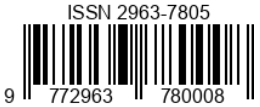Sistem Komunikasi Wearable Yang Menerapkan PCB Fleksibel
DOI:
https://doi.org/10.55606/jtmei.v2i3.3398Keywords:
Wearable Communication, Flexible PCB, Composite Material, ESP32- CamAbstract
The rapid adaptation of Wearable Communication technology to be applied in various fields has shown a remarkable development profile over the past decade. In this research project, a prototype wearable device operating at a frequency of 2.4 GHz was developed using rice husk fiber composite material to construct a flexible PCB Board as a circuit path and shield for IoT component modules and practically tested. This wearable device is designed to transfer video and image streaming data in indoor and outdoor scopes. The sensing object or location captured using the wearable device placed on the user's shirt is connected to an access point and will send the data to a registered server or authorized receiving station. The first trials of the fabricated wearable devices have shown excellent data transmission conducted in two different environments. The maximum communication range between the wearable device and the access point was 87 meters in the indoor test while in the outdoor test the maximum communication distance was 60 meters. During the communication range, the transmission quality degraded so that the sending signal strength during the indoor test was 398 kb/s and the outdoor test was 299 kb/s.
Downloads
References
Aditya, M. A (2020). Sistem Informasi Keamanan Kandang Menggunakan Esp32 Cam Berbasis Internet Of Things. Teknik Elektro, Universitas Muhammadiyah Gresik
Ahaemed A.A (2016). Fabrication and Characterization of Aluminium-Rice Husk Ash Composite Prepared by Stir Casting Method. ISSN 2309-0952, Vol. 44: 9-18, 2016. Rajshahi University Journal of Science & Engineering
Alam Mm, Hamida Eb (2014). Surveying Wearable Human Assistive Technology For Life And Safety Critical Applications: Standards, Challenges And Opportunities. Sensors. Doi: 10.3390/S140509153. MDPI journals
Alam Mm, Arbia Db, Hamida Eb (2015). Research Trends In Multi-Standard Device-To-Device Communication In Wearable Wireless Networks, Part Of The Lecture Notes Of The Institute For Computer Sciences, Social Informatics And TeleCommunication s Engineering Book Series, Hal. 156
Aliverti A. (2017) Wearable Technology: Role In Respiratory Health And Disease. E27-E36. Breathe Journals.
Chen R.S (2019). High loading rice husk green composites: Dimensional stability, tensile behavior and prediction, and combustion properties. Doi.org/10.1177/0892705718815536. Journal of Thermoplastic Composite Materials
Data sheet Document, Esp32-Cam Wifibt Soc Module V 1.0, Shenzhen Ai-Thinker Technology Co.Ltd. On Line Available At Website: Www.Ai-Thinker.Com
Dunne, L. E., Profita, H., Zeagler, C., Clawson, J., Gilliland, S., Do, E. Y.-L., & Budd, J. (2014). The Social Comfort Of Wearable Technology And Gestural Interaction. In Proceedings Of The 36th Annual International Conference Of The Ieee Engineering In Medicine And Biology Society Hoboken. Doi:10.1109/Embc.2014.6944540. IEEE
Gibson, F Ronald (1994) Principles Of Composite Material Mechanics, Mcgrawhill.
Iztok Hrga (2019). Wearable Technologies: Between Fashion, Art, Perfomance, And Science (Fiction). University of Ljubljana, Faculty for Natural Sciences and Engineering, Slovenia Doi: 10.14502/Tekstilec2019.62.124-136
Jungs. S, dkk (2015). Wearable Fall Detector Using Integrated Sensor and Energy Device, Doi.org/10.1038/srep17081. Scientific Report nature research
Miao Liu, Ke Han, Xiao Lv (2020). Influence Of Optimization Design Based On Artificial Intelligence And Internet Of Things On The Electrocardiogram Monitoring System, Internet Of Medical Things For Healthcare Engineering. Doi:10.1155/2020/8840910. Hindawi Publishing Corporation
Downloads
Published
How to Cite
Issue
Section
License
Copyright (c) 2023 Jurnal Teknik Mesin, Industri, Elektro dan Informatika

This work is licensed under a Creative Commons Attribution-NonCommercial-ShareAlike 4.0 International License.








